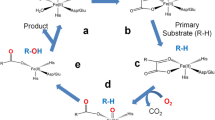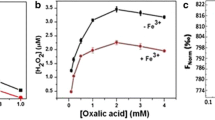Abstract
Taurine/α-ketoglutarate (αKG) dioxygenase (TauD) is an E. coli nonheme Fe2+- and αKG-dependent metalloenzyme that catalyzes the hydroxylation of taurine, leading to the production of sulfite. The metal-dependent active site in TauD is formed by two histidine and one aspartate that coordinating to one face of an octahedral coordination geometry, known as the 2-His-1-carboxylate facial triad. This motif is found in many nonheme Fe2+ proteins, but there is limited information on the thermodynamic parameters that govern metal-ion binding to this site. Here, we report data from calorimetry and related biophysical techniques to generate complete thermodynamic profiles of Mn2+ and Co2+ binding to TauD, and these values are compared to the Fe2+ data reported earlier Henderson et al. (Inorg Chem 54: 2278–2283, 2015). The buffer-independent binding constants (K) were measured to be 1.6 × 106, 2.4 × 107, and 1.7 × 109, for Mn2+, Fe2+, and Co2+, respectively. The corresponding ΔG° values were calculated to be − 8.4, − 10.1, and − 12.5 kcal/mol, respectively. The metal-binding enthalpy changes (ΔH) for these binding events are − 11.1 (± 0.1), − 12.2 (± 0.1), and − 16.0 (± 0.6) kcal/mol, respectively. These data are fully consistent with the Irving–Williams series, which show an increasing affinity for transition metal ions across the periodic table. It appears that the periodic increase in affinity, however, is a result of a complicated summation of enthalpy terms (including favorable metal-ion coordination processes and unfavorable ionization events) and related entropy terms.







Similar content being viewed by others
References
Xiao Z, Wedd AG (2010) The challenges of determining metal-protein affinities. Nat Prod Rep 27:768–789. https://doi.org/10.1039/b906690j
Waldron KJ, Robinson NJ (2009) How do bacterial cells ensure that metalloproteins get the correct metal? Nat Rev Microbiol 7:25–35. https://doi.org/10.1038/nrmicro2074
Reyes-Caballero H, Campanello GC, Giedroc DP (2011) Metalloregulatory proteins: metal selectivity and allosteric switching. Biophys Chem 156:103–114. https://doi.org/10.1016/j.bpc.2011.03.010
Rutherford JC, Bird AJ (2004) Metal-responsive transcription factors that regulate Iron, Zinc, and Copper homeostasis in eukaryotic cells. Eukaryot Cell 3:1–13. https://doi.org/10.1128/EC.3.1.1-13.2004
Waldron KJ, Rutherford JC, Ford D, Robinson NJ (2009) Metalloproteins and metal sensing. Nature 460:823–830. https://doi.org/10.1038/nature08300
Laity JH, Andrews GK (2007) Understanding the mechanisms of zinc-sensing by metal-response element binding transcription factor-1 (MTF-1). Arch Biochem Biophys 463:201–210. https://doi.org/10.1016/j.abb.2007.03.019
Waldon WE, Selezneva AI, Dupuv J, Volbeda A, Fontecilla-Camps JC, Theil EC, Volz K (2006) Structure of dual function iron regulatory protein 1 complexed with ferritin IRE-RNA. Science 314:1903–1909. https://doi.org/10.1126/science.1133116
Phillips CM, Schreiter ER, Guo Y, Wang SC, Zamble DB, Drennan CL (2008) Structural basis of the metal specificity for nickel regulatory protein NikR. Biochemistry 47:1938–1946. https://doi.org/10.1021/bi702006h
Cavet JS, Meng W, Pennella MA, Appelhoff RJ, Giedroc DP, Robinson NJ (2002) A nickel-cobalt-sensing ArsR-SmtB family repressor: contributions of cytosol and effector binding sites to metal selectivity. J Biol Chem 277:38441–38448. https://doi.org/10.1074/jbc.M207677200
Smirnova IV, Bittel DC, Ravindra R, Jiang H, Andrews GK (2000) Zinc and cadmium can promote rapid nuclear translocation of metal response element-binding transcription factor-1. J Biol Chem 275:9377–9384. https://doi.org/10.1074/jbc.275.13.9377
Li Y, Kimura T, Huyck RW, Laity JH, Andrews GK (2008) Zinc-induced formation of a coactivator complex containing the zinc-sensing transcription factor MTF-1, p300/CBP, and Sp1. Mol Cell Biol 28:4275–4284. https://doi.org/10.1128/MCB.00369-08
Andrews SC, Robinson AK, Rodríguez-Quiñones F (2003) Bacterial iron homeostasis. FEMS Microbiol Rev 27:215–237. https://doi.org/10.1016/S0168-6445(03)00055-X
Tottey S, Waldron KJ, Firbank SJ, Reale B, Bessant C, Sato K, Cheek TR, Gray J, Banfield Dennison C, Robinson NJ (2008) Protein-folding location can regulate manganese-binding versus copper- or zinc-binding. Nature 455:1138–1142. https://doi.org/10.1038/nature07340
Kudva R, Denks K, Kuhn P, Vogt A, Muller M, Koch HG (2013) Protein translocation across the inner membrane of Gram-negative bacteria: the Sec and Tat dependent protein transport pathways. Res Microbiol 164:505–534. https://doi.org/10.1016/j.resmic.2013.03.016
Anton A, Grosse C, Reissmann J, Pribyl T, Nies DH (1999) CzcD is a heavy metal ion transporter involved in regulation of heavy metal resistance in Ralstonia sp. strain CH34. J Bacteriol 181:6876–6881
Dudev T, Lim C (2014) Competition among metal ions for protein binding sites: determinants of metal ion selectivity in proteins. Chem Rev 114:538–556. https://doi.org/10.1021/cr4004665
Andreini C, Bertini I, Cavallaro G, Holliday GL, Thornton JM (2008) Metal ions in biological catalysis: from enzyme databases to general principles. J Biol Inorg Chem 13:1205–1218. https://doi.org/10.1007/s00775-008-0404-5
Dupont CL, Yang S, Palenik B, Bourne PE (2006) Modern proteomes contain putative imprints of ancient shifts in trace metal geochemistry. Proc Natl Acad Sci USA 103:17822–17827. https://doi.org/10.1073/pnas.0605798103
Irving H, Williams RJP (1948) Order of stability of metal complexes. Nature 162:746–747. https://doi.org/10.1038/162746a0
Holm RH, Kennepohl P, Solomon EI (1996) Structural and functional aspects of metal sites in biology. Chem Rev 96:2239–2314. https://doi.org/10.1021/cr9500390
Foster AW, Osman D, Robinson NJ (2014) Metal preferences and metallation. J Biol Chem 289:28095–28103. https://doi.org/10.1074/jbc.R114.588145
Yang T-Y, Dudev T, Lim C (2008) Mononuclear versus binuclear metal-binding sites: metal-binding affinity and selectivity from PDB survey and DFT/CDM calculations. J Am Chem Soc 130:3844–3852. https://doi.org/10.1021/ja076277h
Henderson KL, Li M, Martinez S, Lewis EA, Hausinger RP, Emerson JP (2017) Global stability of an α-ketoglutarate-dependent dioxygenase (TauD) and its related complexes. Biochim Biophys Acta 1861:987–994. https://doi.org/10.1016/j.bbagen.2017.02.018
Eichhorn E, van der Ploeg JR, Kertesz MA, Leisinger T (1997) Characterization of alpha-ketoglutarate-dependent taurine dioxygenase from Escherichia coli. J Biol Chem 272:23031–23036. https://doi.org/10.1074/jbc.272.37.23031
Finney LA, O’Halloran TV (2003) Transition metal speciation in the cell: insights from the chemistry of metal ion receptor. Science 300:931–936. https://doi.org/10.1126/science.1085049
Hangasky JA, Taabazuing CY, Valliere MA, Knapp MJ (2013) Imposing function down a (cupin)-barrel: secondary structure and metal stereochemistry in the αKG-dependent oxygenases. Metallomics 5:287–301. https://doi.org/10.1039/c3mt20153h
Koehntop KD, Emerson JP, Que L (2005) The 2-His-1-carboxylate facial triad: a versatile platform for dioxygen activation by mononuclear non-heme iron(II) enzymes. J Biol Inorg Chem 10:87–93. https://doi.org/10.1007/s00775-005-0624-x
Neidig ML, Brown CD, Light KM, Fujimori DG, Nolan EM, Price JC, Barr EW, Bollinger JM, Krebs C, Walsh CT, Solomon EI (2007) CD and MCD of CytC3 and taurine dioxygenase: role of the facial triad in α-KG-dependent oxygenases. J Am Chem Soc 129:14224–14231. https://doi.org/10.1021/ja074557r
Hausinger RP (2004) Fe(II)/α-ketoglutarate-dependent hydroxylases and related enzymes. Crit Rev Biochem Mol Biol. https://doi.org/10.1080/10409230490440541
Henderson KL, Müller TA, Hausinger RP, Emerson JP (2015) Calorimetric assessment of Fe2 + binding to α-ketoglutarate/taurine dioxygenase: ironing out the energetics of metal coordination by the 2-his-1-carboxylate facial triad. Inorg Chem 54:2278–2283. https://doi.org/10.1021/ic502881q
Grossoehme NE, Spuches AM, Wilcox DE (2010) Application of isothermal titration calorimetry in bioinorganic chemistry. J Biol Inorg Chem 15:1183–1191. https://doi.org/10.1007/s00775-010-0693-3
Song H, Wilson DL, Farquhar ER, Lewis EA, Emerson JP (2012) Revisiting zinc coordination in human carbonic anhydrase II. Inorg Chem 51:11098–11105. https://doi.org/10.1021/ic301645j
Jackson VE, Felmy AR, Dixon DA (2015) Prediction of the pKa’s of aqueous metal ion +2 Complexes. J Phys Chem A 119:2926–2939. https://doi.org/10.1021/jp5118272
Marcus Y (1983) Ionic radii in aqueous solutions. J Solut Chem 12:271–275. https://doi.org/10.1007/BF00646201
Inada Y, Sugimoto K, Kichi S, Ozutsumi K, Funahashi S (1994) Solvation Structures of Manganese(II), Iron(II), Cobalt(II), Nickel(II), Copper(II), Zinc(II), Cadmium(II), and Indium(III) Ions in 1,1,3,3-Tetramethylurea As Studied by EXAFS and electronic spectroscopy. Variation of coordination number. Inorg Chem 33:1875–1880. https://doi.org/10.1021/ic00087a024
O’Brien JT, Williams ER (2011) Coordination numbers of hydrated divalent transition metal ions investigated with IRPD spectroscopy. J Phys Chem A 115:14612–14619. https://doi.org/10.1021/jp210878s
Goldberg RN, Kishore N, Lennen RM (2002) Thermodynamic quantities for the ionization reactions of buffers. J Phys Chem Ref Data 31:231–370. https://doi.org/10.1063/1.1416902
NIST Standard Reference Datebase 46 (2003) Technology, National Institute of Standards and Technology, Gaithersburg, VA
Chaplin M, Bucke C (1990) Enzyme technology. Cambridge University Press, Cambridge
Acknowledgements
Portions of this work were supported by the National Institutes of Health Grant GM063584 (RPH).
Author information
Authors and Affiliations
Corresponding author
Electronic supplementary material
Below is the link to the electronic supplementary material.
Rights and permissions
About this article
Cite this article
Li, M., Henderson, K.L., Martinez, S. et al. The Irving–Williams series and the 2-His-1-carboxylate facial triad: a thermodynamic study of Mn2+, Fe2+, and Co2+ binding to taurine/α-ketoglutarate dioxygenase (TauD). J Biol Inorg Chem 23, 785–793 (2018). https://doi.org/10.1007/s00775-018-1574-4
Received:
Accepted:
Published:
Issue Date:
DOI: https://doi.org/10.1007/s00775-018-1574-4




